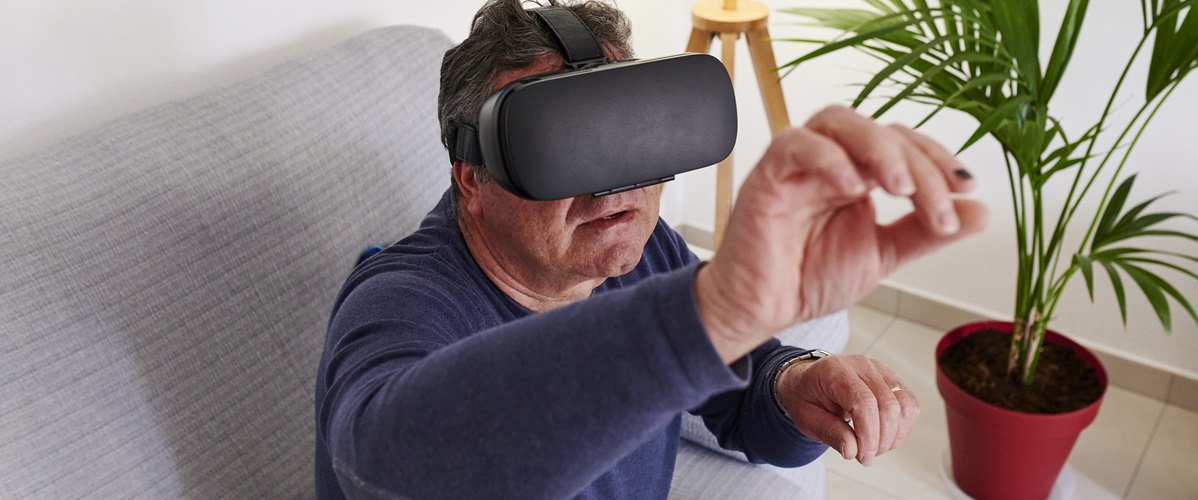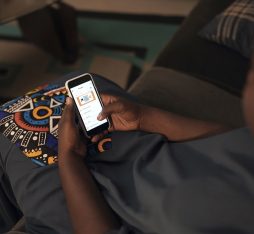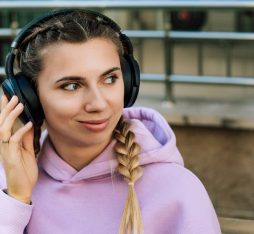Over the past 30 years, the uses of virtual reality have been evolving in the field of psychiatry. The fall in the price of headsets has made this technology — once reserved for a handful of cutting-edge university hospital departments — more widely available. In France, it has spread to both hospitals and the private sector. It is mainly used to treat phobias and anxiety disorders, but also post-traumatic disorders, eating disorders, cognitive disorders, stress and addictions. In terms of addiction treatment, it allows patients to train virtually, in the safe environment of withdrawal in the hospital, to learn how to deal with situations in their daily life that are conducive to addictive behaviour. This technology is used to prepare for discharge in anticipation of the risk of relapse once the patient returns home.
Although poor graphic realism may not necessarily be detrimental, the lack of social plausibility can put the simulation to a test.
Study in an addiction treatment department
To better understand the practical deployment of the therapeutic uses of virtual reality in addiction treatment, I conducted an investigation entitled “Digital Detox”, funded by DREES (Direction de la recherche, des études, de l’évaluation et des statistiques — the French Directorate for Research, Studies, Evaluation and Statistics), a ministerial department in the health and social fields, as part of a collaborative research contract between Orange and EHESS (École des Hautes Études en Sciences Sociales — School for Advanced Studies in the Social Sciences).
We spent 10 days with Elsa Forner, a postdoctoral student of this research, in the addiction treatment department of a Parisian hospital that routinely uses virtual reality.
In this context, virtual reality is the last step in the care plan for patients hospitalised for a fortnight. First, patients undergo physical withdrawal with the aid of medication. They then attend therapeutic groups during which they learn cognitive and behavioural strategies to avoid relapse. Finally, they do two to three sessions of virtual reality, considered to be a practical application of the theoretical learning in the groups.
Each one-hour session is made up of three 20-minute sequences: a discussion between the therapist and the patient, immersing the patient in virtual environments with the headset and controllers, and a debrief.
Exposure in a virtual environment
Virtual reality is used to implement strategies conventionally used in cognitive behavioural therapy (CBT). The exposure aims to help the individual develop new cognitive and behavioural responses to situations they find problematic. involves exposing individuals to virtual environments.
For addictions, whether substance-related (alcohol, tobacco, cocaine etc.) or behavioural (gambling, compulsive shopping etc.), VRET aims to work on the “ ”, the irrepressible desire to consume a substance or to engage in an activity. It consists of exposing patients to situations, substances and places that are associated with their addiction and likely to lead to a relapse.
Therapists typically use virtual environments as part of dedicated training. These environments allow for various scenarios: For example, the patient can sit at a bus stop with people smoking around them or in a living room with a bottle of wine on the table. Patients can move and manipulate certain objects, while therapists can tailor the environment’s characteristics (time of day, presence of avatars, adding objects etc.). Therapists can also work with short 3D films shot with 360° cameras, but these are not interactive. This allows exposure to social scenes, such as a bar or supermarket. Lastly, the Google Earth app can be used to place patients in familiar surroundings.
Taming cravings
VRET offers a type of practical simulation with a learning objective: to help patients change their attitude in situations that are conductive to addictive behaviour and therefore avoid relapses. The simulation is configured as a learning situation through a certain type of interaction and dialogue between the patient and the therapist, in support of the virtual experience. The therapist encourages the patients to reflect on their craving. Training in the virtual environment is designed to develop reflexivity, to form feedback about their own actions. The aim is to trigger the patient’s craving in order to teach them to control it.
According to an addictologist, VRET consists of “activating the reward circuit”, but without “overwhelming” the patient, who must be able to return to “their initial state” at the end of the session, alternating between stimulation and relaxation (visualising soothing scenes). This doctor emphasises the importance of “playing on the difference between the two psychological states” to help patients “find their own point of reference”. It allows patients to experience their craving and, above all, how it may vary.
The addictologist tells patients how to act in the virtual environments, such as throwing alcohol bottles in the bin or going out on the balcony to get some fresh air, to help them develop strategies to reduce their craving. The goal is to make them realise that they can reduce this craving by changing the situation they are in through their own actions.
Transposing everyday situations into virtual environments aims to establish the craving no longer as a sensation paralysing the ability to act, but as an object that the patient can learn to master, starting by evaluating it (on a scale of 0 to 10).
Mapping addictive practices
The challenge of addiction treatment is continuing withdrawal after hospitalisation. It is in this context that VRET is used because the daily situations in which addictive behaviours emerge can be “reproduced” from the safe space of the hospital.
Therapists consider that VRET gives patients a hybrid environment, where they can simultaneously be within the safe walls of the hospital (a bubble in which ordinary life is almost put on hold) and outside the hospital, in situations that could lead to relapse. They see it as a means to minimise the stark opposition between inside and outside that characterises hospitalisation.
An addictologist explained: “Before, the idea was to shelter patients, but as soon as people returned to their daily environments, they relapsed again. We heard it all the time! There was too great a disconnect between their daily environments and the workshops in the hospital. They alternate between nothing in the hospital, no craving, and everything at home, when they go back. It’s because the hospital is a bubble. Hospitalisation resets the addictogenic environment. But it does patients a disservice. They are under the illusion of not having any craving and they’re caught off-guard when they go home. […] With virtual reality, we’re working on the transition. […] So we’re preparing for this goal of returning home. Otherwise, the addiction just waits for them to be released to come back.”
Work on the environment follows a mapping approach. The goal is to create and gradually extend a “free zone”, a “movement area where the craving is weakened”. The environment is divided into distinct “layers”: from their mobile phone (removing their dealer from their contacts) to home (training in a virtual apartment), to their neighbourhood (using Google Earth to identify places of risk or “hotspots” and map out new daily routes to avoid them). As the addictologist explained: “We reintroduce layers into the environment at the right time for the patient. And we expand them as we go.”
Customising exposure situations
Customising exposure situations, adapting them to each patient’s addictive practices, involves not only places but also times of day and the objects used. The addictologist asks patients to describe their experiences very precisely in order to identify the triggers. They want to understand the details of each patient’s daily life to capture their unique habits.
Prior to the virtual simulation, the addictologist establishes the patient’s profile by showing them photos related to their addictive practices: substances in different forms and in different containers; places of consumption; logos; signage; accessories and gestures. The addictologist shows a photo for about three seconds, then asks the patient to measure their craving and say what they feel. The addictologist usually goes through around 20 photos. This phase allows each patient to recreate their personal history with addiction and to begin to work on reflection.
Alain, a 65-year-old patient hospitalised for alcoholism, explained: “This is not the kind of bar I like. What I like are old Parisian bistros. I like bistros in the cultural sense of the term, as a typically Parisian environment.” In this case, the addictologist identifies two key moments with the patient: buying prosecco at the local Monoprix store for an aperitif and tasting a glass of white wine with the oyster seller at the market on Saturday morning.
During the virtual reality exposure, the addictologist takes care to choose environments adapted to each patient’s habits, even if they test several. The doctor also makes sure to fill the environment with specific items, choosing the type of alcohol consumed, changing the external light according to the intended times of day, and adding items such as a mobile phone or a turned-on TV, depending on the habits associated with the addictive practices.
Learning “as if”
During the sessions, patients become familiar with the tool. They co-build the virtual environment with the doctor, they take ownership of the technical tool and make their mark in two places at once (the hospital room and the virtual environment).
More importantly, patients learn to do “as if”: as if they were in their own apartment, as if they were going to this type of bar etc. The patient and the therapist agree to “play the game”, which makes it possible to build time-based forms of reflexivity, upstream and downstream from real world interaction. Examples of this include preparing for a future action (such as a planned party) or returning to a past action to guide future behaviour (in the case of a “debrief” after a period of leave).
Reflexivity stems from the back and forth between constructing the virtual and constructing the real, rather than from conditioning in a virtual environment that is directly transposed into real-life situations. This back-and-forth movement takes place in discussions between the patient and the therapist that describe and contextualise addictive practices, take stock of past experiences and project onto future situations. Therefore, virtual reality gives the patient the power to act for themselves by offering them a semi-fictional, semi-real intervention space.
The importance of social plausibility
Despite the obvious care needed around customising virtual environments, what matters is not so much their graphic realism as the socialisation of the patient to the simulation. In this respect, although poor graphic realism may not necessarily be detrimental, a lack of social plausibility can put the simulation to a test. This issue has two components: the socially situated nature of addictive practices and their relational aspect.
First of all, addictive practices, like all practices, are socially situated, i.e. they vary according to the social characteristics of the patient. In virtual environments, expressions of taste can create tensions with the realism of the simulated social context (“This is not the kind of bar I like” in Alain’s case). Individuals’ preferences and aversions express their position in the social world (Bourdieu, 1979). By producing a “distinction”, patients report that the situation is not plausible from the point of view of their place in the social order.
Nevertheless, they usually manage to overcome this block and learn to “act as if”, using the elements present as pointers that let them build a training situation (“Let’s say it is the bar I usually go to”). Discussions about the social labelling of addictive practices usually result in an agreement between the patient and the therapist.
The social aspect of simulated situations also refers to the relational nature of addictive practices. Situations likely to lead to relapse are often characterised by the presence of “significant others” for the patient (Mead, 1934): the oyster seller from the market, friends in a restaurant etc. Addictive practices are closely linked to social relationships.
Therapists are aware of this aspect but struggle to take it into account in the context of VRET. VRET targets certain situations but dissociates addictive practices from their social contexts. While addictologists strive to design virtual environments down to the finest detail, they do not see a way to integrate people, especially relatives (friends and family), into these environments in order to improve exposure situations.
Therefore, it seems that, with VRET, it is not possible to treat the collective aspect of addiction behaviours. For example, consuming as a couple is perceived as a situation that is likely to put this tool, aimed at individuals, in check. An addictologist admits that VRET cannot be used to work on the “purely relational aspect” of addictive practices. This relational aspect therefore seems to be a stumbling block in the modelling and implementation of virtual training situations; using other tools, such as couples therapy, can help to overcome this gap.
Outlook
This case study shows that the lack of graphic realism is not necessarily a barrier to using virtual reality for training situations. Immersion in a virtual environment that is graphically unrealistic can create a specific sense of presence, allowing people to engage in the mode of training. Our analysis even suggests that an overly realistic virtual environment would not be conducive to training, as it would not allow the reflexivity necessary for learning.
Similarly, we can assume that the increasing use of virtual reality as an awareness tool to better understand the views of others in problematic situations (harassment, sexual violence, gender discrimination, racism) should be based on the disconnect between the emotional stimulation produced by the feeling of presence in a virtual environment, and preserving a reflexive capacity by implementing an experience that is not fully immersive.
Finally, by showing that the lack of social plausibility in exposure situations can hinder simulations, this study invites a broader reflection on the importance of social plausibility in other instances of virtual reality use. It draws attention to how the social dimension is important in virtual situations, both in terms of lifestyles according to social characteristics (age, gender, social class etc.) and relationships.
Sources :
Bourdieu, P., 1979. La distinction. Critique sociale du jugement. Editions de Minuit.
Mead, G.H., 1934. Mind, Self, and Society from the Standpoint of a Social Behaviorist. The University of Chicago Press.
Read more :
Borelle Céline & Former Elsa, 2024, « Reality check: The issue of social plausibility in Virtual reality therapy with addiction patients”, Social Science & Medecine, vol 344 Reality check. The issue of social plausibility in Virtual reality therapy with addiction patients – ScienceDirect
Strategy adopted in the context of cognitive behavioural therapies which involves putting a person in a situation that is challenging for them.
Virtual reality exposure therapy (VRET)
A concept that refers to exposing patients to virtual environments.
Term used in addiction treatment to designate the irrepressible desire to consume a substance or to engage in an activity.












